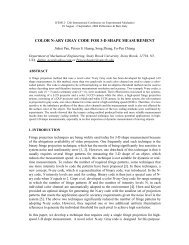First of all, we thank you for your great effort reviewing our paper ...
First of all, we thank you for your great effort reviewing our paper ...
First of all, we thank you for your great effort reviewing our paper ...
- No tags were found...
You also want an ePaper? Increase the reach of your titles
YUMPU automatically turns print PDFs into web optimized ePapers that Google loves.
For instance, a recent <strong>paper</strong> [1] Zhang ZH, et.al can also simultaneously capture both 3D andcolor texture in<strong>for</strong>mation using readily available hardware [1]. They claim f<strong>our</strong> images arerequired <strong>for</strong> a RGB f<strong>our</strong> phase shifted method, or a single image <strong>for</strong> a FFT method. Theirsolution to the color bleeding problem ho<strong>we</strong>ver requires a model <strong>of</strong> the color bleeding andusing nonlinear regression to find the color modulation and phase in<strong>for</strong>mation.We added in Section 1, on page 4 to cite Zhang ZH and his collaborators f<strong>our</strong> <strong>paper</strong>s related tocolor problem:Zhang et al proposed a technique to <strong>all</strong>eviate the color coupling problems <strong>of</strong> the system [11, 12,13]. For this technique, it utilized a 3x3 matrix to represent the color coupling effect <strong>of</strong> thesystem, which was a pretty nice approach to deal with the color coupling problem. Ho<strong>we</strong>ver,calibrating the color coupling matrix could be a complicated issue since each pixel might haveslightly different responses if the lens chromatic aberration is considered. In 2008, theyproposed another approach to deal with color bleeding (or coupling) [14]. For this approach,f<strong>our</strong> fringe images are required (even though they claimed that a single image using a FFTmethod might be feasible, which have not been proven yet). Ho<strong>we</strong>ver, this technique requiresa model <strong>of</strong> the color bleeding that uses nonlinear regression to find the color modulation andphase in<strong>for</strong>mation. All above mentioned <strong>paper</strong>s by Zhang and his collaborators tried to solvethe problem <strong>of</strong> measuring color and geometry simultaneously by utilizing 3‐CCD color cameras.Ho<strong>we</strong>ver, none <strong>of</strong> them is suitable <strong>for</strong> real‐time 3D shape measurement since more than 3fringe images are utilized to deal with color related issues. In general, <strong>all</strong> the techniques usingcolor fringe images suffer the problem: they may not measure the surface pr<strong>of</strong>ile properly. Forexample, <strong>for</strong> a red object, the green and blue light will be absorbed, and the in<strong>for</strong>mationcarried on by these color fringes will be lost.Another <strong>of</strong> Zhang ZH,et.al's recent publications [2] avoids the color coupling problem byprojecting RGB channels separately. Their computations <strong>for</strong> computing phase and color appearto be a f<strong>our</strong> phase shifted fringe version <strong>of</strong> what appears in this <strong>paper</strong> by Zhang S. They pick theRGB channel with the largest modulation to compute the phase from, and use the RGBchannels to compute the color texture. T<strong>we</strong>lve RGB frames are needed to acquire the data(compared to three RGB frames <strong>for</strong> Zhang S and Yau). Zhang ZH's <strong>paper</strong> also shows there isinterest in this problem and gives further support to why this <strong>paper</strong> by Zhang S and Yau shouldlikewise be published.Same as aboveCONSThe <strong>paper</strong> does not seem to emphasize or adequately explain the principles and advantages <strong>of</strong>the main technique used to overcome the color bleeding and object color problems. The overemphasison using a Bayer color filter distracts from key points <strong>of</strong> the <strong>paper</strong>, especi<strong>all</strong>yconsidering a 3‐CCD camera should achieve the same results. The key points to solve the colorproblems should be presented, then the addition <strong>of</strong> the Bayer filter discussed.
















